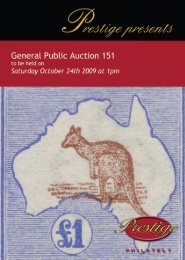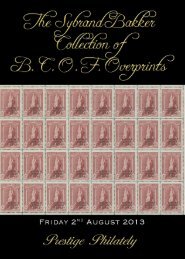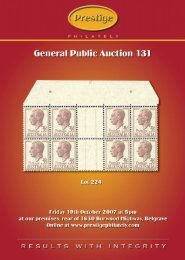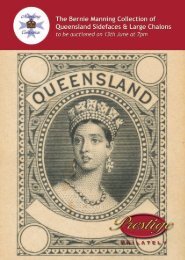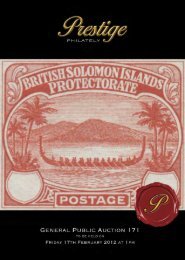Auction No 145 - Prestige Philately
Auction No 145 - Prestige Philately
Auction No 145 - Prestige Philately
Create successful ePaper yourself
Turn your PDF publications into a flip-book with our unique Google optimized e-Paper software.
Jun 13, 2009<br />
<strong>Prestige</strong> <strong>Philately</strong> - <strong>Auction</strong> <strong>No</strong> <strong>145</strong> Page: 5<br />
Understanding our Symbols & Unique Grading System<br />
At <strong>Prestige</strong> <strong>Philately</strong> we utilise much the same symbols as other firms, but with some additional categories that you should be aware of.<br />
We are the only major firm in the world that actually grades the quality of the material we offer. While some clients have struggled with<br />
the whole concept of grading, most have clearly embraced the idea and we receive much favourable comment about the system. It is<br />
important that you understand our Grading System because the symbols used form part of the lot description. We are confident that<br />
once you are comfortable with our gradings, you will always be satisfied with the quality of the material you purchase from us. And, in the<br />
event that we have missed a tear or a thin and consequently overgraded an item, we WANT you to return it. We stand behind the <strong>Prestige</strong><br />
Grading System.<br />
1. Firstly, we have the lot number. If it is in bold and printed in bright red, the item is illustrated: e.g. 1234. (The actual location of the<br />
illustration is given at the end of the description: e.g. {Page 41.8} is position 8 on page 41.)<br />
2. The second column contains a symbol, which represents the item(s) in the lot:<br />
** Mint, unmounted o.g. * Mint, mounted o.g.<br />
Ω Unused, no gum Δ Piece<br />
C Cover or card PS Postal Stationery<br />
CL Cover, long CX Cover, oversize<br />
A Albums and accessories B Booklet<br />
E Essay L Literature<br />
P Proof R Reprint<br />
S Stamp (“Postmarks” lots)<br />
or, in the case of used stamps, a grading of the cancellation:<br />
V Neat postmark, leaving most of the stamp design clear O Used, quality unspecified<br />
F Neat postmark, across at least half of the stamp design G Untidy or indistinct postmark<br />
H Heavy or poorly struck postmark<br />
3. The third column gives an overall quality assessment for the lot, from ‘A’ to ‘D’. The same standard applies to mint and used stamps, to<br />
covers, postal stationery, literature etc. An item graded ‘A’ is very fine; it has no faults. ‘B’ items are fine and may have minor imperfections.<br />
A ‘C’ item will exhibit obvious faults. Items in poor condition are rated ‘D’.<br />
Occasionally, an item in truly superb condition will be rated ‘A+’. This grading is used sparingly and is not applied to modern material, which<br />
one would normally expect to be in very fine to superb condition.<br />
An otherwise very fine item which has a subsidiary problem may be allocated an ‘A-’. This may be a stamp with writing or a hinge remainder<br />
on the reverse. A cover may have a receiver’s endorsement on the face. The halves of a letter card may be stuck together. A book may<br />
have a previous owner’s notations. Whether this factor makes the item an ‘A-’ or ‘B’ is a matter of degree. NB: An expertiser’s signature or<br />
handstamp on a cover or the reverse of a stamp will not normally be cause for downgrading the quality of an item: such marks will be<br />
mentioned and you should make your decision as to whether or not such an item is of the standard that you personally require.<br />
Occasionally, the symbol ‘A’ to ‘C’ will appear in brackets: eg (B). This signifies that the item has been renovated or repaired and improved<br />
to the grade indicated by the letter. The brackets indicate a qualified grading, the cause for which will be mentioned in the description of the<br />
lot.<br />
4. The fourth column is relevant to perforated stamps, and also to lots listed under the sub-heading ‘Postmarks’.<br />
For perforated stamps, this column gives a grading for both centring and perforations. The letter ‘A’ to ‘D’ relates to centring. ‘A’ stamps<br />
are very well centred; ‘B’ stamps are slightly off-centre; ‘C’ stamps are significantly off-centre, and may have the perforations slightly into the<br />
design; ‘D’ stamps are badly off-centre, with the perforations well into the design.<br />
[NB: These gradings are the same for all perforated issues, whether Australian Decimals, De La Rue Colonial keyplates or 19 th Century<br />
American issues. However, it should be understood that for many issues poor centring is the norm. Thus ‘C’, and even ‘D’, gradings should<br />
be expected and accepted. For such issues a ‘B’ stamp will be above-average and an ‘A’ stamp will be considered an exceptional copy.]<br />
Following the letter ‘A’ to ‘D’ is a number ‘1’ to ‘4’. A stamp with all perforations intact is ‘1’. One or two short perfs, or normal rough<br />
perforations, will drop the grading to ‘2’. More notable perforation problems such as the perfs down one side being trimmed will result in a ‘3’<br />
grading. A stamp with major perforation faults will be a ‘4’.<br />
[NB: A stamp graded ‘A1’ is well-centred with all perforations intact. In many cases, particularly with modern issues, this is the norm.<br />
However, for many issues, ‘B2’ or even ‘C3’ may be normal and quite acceptable.]<br />
For lots listed under the sub-headings “Postmarks” and “Ship/Paquebot Markings”, or similar, this column gives a grading for quality of<br />
the strike of the marking itself, and completeness. Quality is graded from ‘A’ (very fine) to ‘D’ (poor). Completeness is graded from ‘1’<br />
(complete) to ‘5’ (identifiable only). ‘+’ is used for superb strikes; ‘-’ is used for postmarks that are lightly struck, a little doubled, or otherwise<br />
a bit short of the mark.<br />
5. The symbols in the second, third and fourth columns, and the illustrations of lots, form part of the lot description.<br />
6. Figures in the right-hand column are our estimate of value. (If a lot attracts tax for Australian buyers, the estimate is in green, followed<br />
by a small "T".) You may bid at, above or below estimate. The reserve price for almost every lot is 75% of estimate (rounded to the nearest<br />
bidding step). Bids below this level will not be considered.<br />
7. We use the following standardised abbreviations:<br />
o.g. original gum opt(d) overprint(ed) PPC picture postcard<br />
d/s datestamp cds circular datestamp h/s handstamp<br />
mss manuscript; handwritten ERD earliest recorded date LRD latest recorded date<br />
o/o opened-out RLabel registration label M/S(s) miniature sheet(s)



